How Many Teeth Do Cats Have? the common question among people who study cats is what number of teeth these animals possess. The dental form of cats operates separately from other species because it matches their food requirements. The number of teeth in a cat requires knowledge for proper veterinary care to ensure their complete health. The following text explains domestic cat teeth count in kittens and adults together with tooth use explanations and cat dental maintenance instructions.
How Many Teeth Do Cats Have? Understanding the Basics
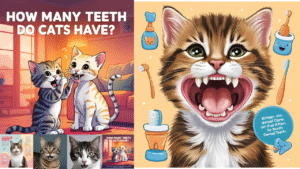
The fundamental question needs an immediate response about the complete number of teeth that cats possess. Throughout adulthood domestic cats possess a total of thirty teeth which include both incisors along with canines and premolars and molars. The teeth perform essential dietary functions which enable cats to both tear and chew their food items. Cats possess thirty teeth during their complete growth stage. The tooth count stays steady throughout the adulthood of most cats.
The adult cat maintains thirty teeth throughout its lifetime.

Adult cats generally have 30 teeth. The total number of thirty teeth is split between four dental categories including incisors and canines and premolars and molars. Here’s the breakdown:
- Incisors: 12 total
- Canines (fangs): 4 total
- Premolars: 10 total
- Molars: 4 total
The following sections will explore each kind of feline tooth together with its essential functions.
Cat teeth consist of twelve incisors located in front positions.
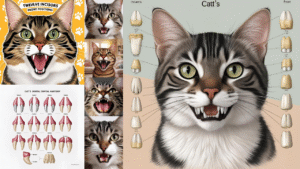
How Many Teeth Do Cats Have? Most queries regarding the teeth count on a cat’s mouth address its incisor teeth set. The teeth arrangement in cats contains twelve incisors that are distributed across the six upper incisor teeth and six lower incisor teeth. The mouth of cats contains six pairs of small pointed teeth situated right in front. A cat uses its front teeth mainly for food grasping and gentle nibbling actions during prey consumption that involves small objects such as rodents.
How Many Sets of Teeth Do Cats Have?
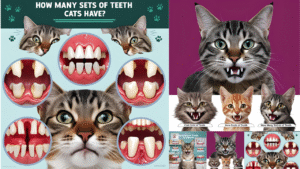
During their life span cats develop two different sets of teeth. When newborn kittens appear they receive baby teeth that will be replaced by permanent adult teeth during adolescence. Kittens experience tooth replacement between their third week of life and six months of age.
Is the proper count of final teeth for cats twenty-six or thirty? Adult cats typically develop thirty teeth like those described in the previous information.
The total number of teeth which kittens possess

Kittens are born without teeth. New teeth arise from their original baby teeth when kittens continue to mature. At 3 weeks of age the kitten develops all 26 baby teeth. When kittens grow older all temporary teeth will drop out which gets replaced by permanent adult teeth.
When kittens experience teething their sore gums are treated by chewing objects as part of their developmental process. The number of teeth that mature kittens possess stands as a matter of curiosity for many individuals. These baby teeth number 26 but will be successively displaced by thirty permanent adult teeth inside their 6-months-old body.
A domestic cat contains thirty teeth in total.
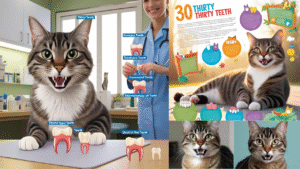
The total dental count for an adult domestic cat matches the other adult cat dental formula at thirty teeth. The tooth arrangement in domestic cats exactly matches those of wild cats given natural evolution for consuming meat-based foods. The domestic cat maintains its hunting teeth for meat ripping yet they do not require this tooth function to the same extent because of their processed cat food.
Stages of Dental Development in Cats
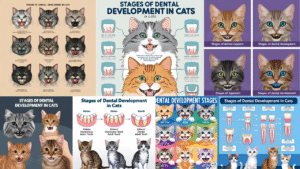
The dental development processes in cats parallel those observed in human beings. The development of adult teeth through the replacement of baby teeth occurs as children transition from infancy to adulthood.
Newborn cats arrive in the world without the presence of any teeth. The first set of baby teeth appears through the gums of kittens during their second to third weeks of life. At the sixth week the kitten develops the complete 26 teeth of their baby tooth series. The temporary teeth will eventually drop out of their sockets.
All adult teeth replace the baby teeth in kittens when they reach 6 months of age. The complete tooth set of 30 permanent teeth appears in a kitten at approximately 1 year of age.
The Various Types Of Teeth Function For A Specific Purpose In Cat Mouth
- Cats possess various tooth types which perform different functions during eating.
- Each of the twelve small incisor teeth allows cats to grasp and nibble pieces of food.
- Fang teeth named canines exist in four numbers to grasp and tear meat as their primary function.
- The ten premolar teeth which support slicing and tearing actions exist in the back area of the mouth.
Molars comprise four teeth which help with food grinding despite the fact that cats do not grind material at the same level as herbivores.
The question stands whether cats develop extra teeth throughout their lives🐾
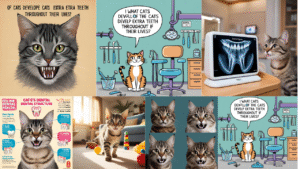
Cats normally do not develop extra teeth during their life span. The adult teeth rarely fail to push the baby teeth from their locations which can result in dental overcrowding. The observation of your cat’s dental health remains essential because dental problems might develop from this condition.
The Correct Procedure for Home-Based Feline Dental Assessment
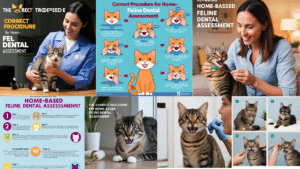
To inspect your cat’s teeth at home you should gently raise their lip while examining their teeth and gums. Look for:
- Swelling combined with redness near the gums appears as a sign.
- Yellow or brown tartar buildup
- Broken or missing teeth
- Bad breath (halitosis)
Any observed dental signs require you to visit a vet for comprehensive dental assessment.
The Science Behind Feline Teeth
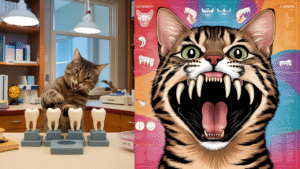
Cats possess teeth which align with their natural meat-consuming eating pattern. The cat’s incisor teeth function for prey grasping so their canines provide the power for meat piercing and maintaining a grip. Raw meat becomes easy to chew through the combined actions of the premolars and molars which also break down bone structures. The complex teeth structure functions as cats’ niche feature because it supports their survival in nature and their capacity to consume healthy foods.
How Many Teeth Does a Cat Have and Why It Matters

Cats possess thirty teeth throughout their lifetime and these teeth serve multiple functions to fulfill their carnivorous eating pattern. The adult cat possesses thirty teeth that perform functions which range between food tearing to predatory activities and recreational movements. Dental health stands vital for cats because dental diseases produce pain along with infections which may result in tooth loss.
Studying tooth counts for domestic cats alongside oral hygiene maintenance enables you to help ensure your pet experience extended professional lifespan. Cats need a combination of routine dental practices which include brushing and professional vet checkups to protect their tooth health.
Take action now that you understand how many teeth a cat possesses to maintain their tooth strength and wellness through numerous years.
1. How many teeth do cats have?
Adult cats have 30 teeth. These include 12 incisors, 4 canines, 10 premolars, and 4 molars. Each tooth plays a specific role in eating and grooming.
2. How many teeth do kittens have?
Kittens have 26 baby teeth (also called deciduous teeth). These start to appear at about 2–3 weeks of age and fall out by the time the kitten is 6 months old, making way for the permanent 30 adult teeth.
3. How many front teeth do cats have?
Cats have 12 front teeth, known as incisors — 6 on the top and 6 on the bottom. These are used for grasping and nibbling on food or grooming.
4. How many sets of teeth do cats have in their lifetime?
Cats have two sets of teeth: Baby teeth (26) Adult teeth (30) The baby teeth are replaced by adult teeth between 3 to 6 months of age.
5. How many teeth do domestic cats have compared to wild cats?
Domestic cats and wild cats generally have the same dental structure. Both have 30 adult teeth, as they're all obligate carnivores with similar dietary needs.
6. How many teeth do cats have compared to dogs?
Cats have 30 teeth, while dogs have 42. Dogs have more molars because they are omnivores and need to grind plant-based foods, whereas cats are meat-eaters and have more cutting and shearing teeth.
7. Can cats grow extra teeth?
It’s rare, but some cats may develop retained baby teeth, where the adult tooth doesn’t push out the baby tooth. This can lead to overcrowding and dental issues, requiring veterinary intervention.
8. How many teeth should a healthy adult cat have?
A healthy adult cat should have 30 teeth. If a cat is missing teeth, it could be due to age, injury, or dental disease, and a vet should evaluate them.
9. How can I tell if my cat has dental problems?
Watch for signs like: Bad breath Drooling Difficulty eating Red or swollen gums Pawing at the mouth If you notice any of these, schedule a dental checkup with your vet.
10. How do I take care of my cat's teeth at home?
Brush their teeth with cat-safe toothpaste, provide dental treats and toys, feed a diet that supports oral health, and schedule regular vet checkups for professional dental care.
11. What should I do if my cat loses a tooth?
While occasional tooth loss may occur with aging, it’s not normal for a healthy adult cat. Consult your vet to rule out infections or underlying dental diseases.
12. How many teeth do house cats have compared to feral cats?
Both house cats and feral cats have 30 teeth as adults. However, feral cats may suffer more dental wear and loss due to eating raw prey and lack of medical care.
13. Do older cats lose teeth naturally?
Some older cats may lose teeth due to periodontal disease or tooth resorption. While not normal, it's relatively common. Good dental hygiene can help prevent this.
14. Is bad breath in cats a dental issue?
Yes. Persistent bad breath (halitosis) in cats often indicates plaque buildup, gum disease, or an infection. A vet should evaluate it.
15. How often should a vet check my cat’s teeth?
Your vet should check your cat’s teeth at least once a year. For senior cats or those with known dental issues, more frequent checkups are recommended.
